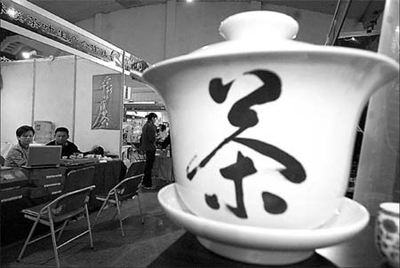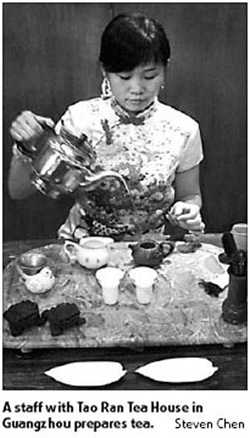A giant tea cup draws much attention at a tea culture exhibition held this April in Hangzhou, East China's Zhejiang Province. Drinking tea has been an integral part of Chinese culture for thousands of years. (Photo:Chinadaily.com.cn)
Guangzhou's preeminent association for female expats may not be the first place one would expect to find fans of one of its more low-key cultural exports. But over the years, an increasing number of members of the Guangzhou Women's International Club (GWIC) have been embracing the art of kungfu tea (gongfu cha) with a passion.
Kungfu tea, in fact only one of many Chinese tea ceremonies, has its origins in East China's Chaozhou, Guangdong Province, during the Song Dynasty (960-1279). The ceremony combines spiritual and ritual, brewing techniques with an appreciation of all these elements, to create an art form.
Today, it remains popular in Guangdong and in the Zhangzhou and Quanzhou areas of Fujian Province. And the GWIC, which boasts a regular membership of 500-plus foreigners from all over the world, regularly arranges trips to Tao Ran Tea House in historic Shamian Island, so that members can be introduced to this traditional pursuit.
"Many of our members are former career professionals - doctors, lawyers, businesswomen - that have agreed to follow their husbands' (relocation) to China," says Diane Ashburner, GWIC president.
"They are interested in kungfu tea, because it is so different and something they have not seen before. In Western countries, tea making is casual, very quick. With kungfu tea, there is a ceremony - all the steps you have to do - and there is a deeper appreciation of the tea and the different tea types."
Due to the strong interest, the GWIC has organized field trips to neighboring Zhongshan, where members can see how tea is grown and prepared and learn more about tea varieties and selection.
During Ashburner's tenure as PTA president at the American International School, kungfu tea was an itinerary highlight for visiting speakers.
"After our introduction, many of our members want to learn more and take up further study of the ceremony themselves. It is a part of China that they bring back with them when they go home."
The members buy the teaware and equipment and perform the ceremony for friends and family, who then start to take an interest. In this way, they are taking Chinese culture abroad, Ashburner says.
Unlike tea as drunk in the West, kungfu tea uses five different holders, including the water pot, and takes about 10 minutes to prepare at the beginner's level, says Vivian Lai, an experienced tea server at Tao Ran.
The water must be pure, so tap water is a no-no. Distilled or natural spring water are best and the boiling temperature at use varies according to the tea - 100 C for black tea, 95 C for Oolong and 80 C for younger green tea.
Tea should be drunk as hot as the drinker can accept, she says, and brewed tea that has been lingering in the teapot (gai wan), should be discarded and new water added, rather than served over-brewed.
The taste of the tea should be soft, sweet and fragrant. The color should be bright and clear.
For true tea lovers, Chinese tea served in restaurants is invariably bad, Lai adds. "It is usually the cheapest tea available and has many (impurities)."
At Tao Ran Tea House, the best teas from Yunnan Province can be anywhere up to 50 years old and cost 1,580 yuan (US$210) per 100 grams. There are more expensive teas around that can run into the tens of thousands for a mere 500 grams, depending on age, location and a myriad of growing factors.
While in practice, any Chinese tea can be used to make kungfu tea, but Oolong teas are the best, insists Peter Xie, a teaware trader at Guangdong Fancun Tea Center, Guangzhou's biggest tea trade market.
"Appreciating the fragrance of the tea is an essential part of kungfu tea. The fragrance of black tea is weak because of the age of the leaves, and the fragrance of green tea - usually used only two months after being picked - is also very weak."
So, oolong tea, usually drunk anywhere from six months to two years after being picked, is best suited, he believes.
To embrace true Chinese tea culture, one needs time, and for real aficionados, money, says Xie.
"Drinking tea is supposed to be a relaxing time. Time to appreciate the tea and to sit back and appreciate life. It is better to drink with a small group of friends. The atmosphere should be quiet, not noisy."
"I love the ceremony and all the steps there are," says Ashburner. "Now, every day, I find some quiet time for myself and drink Chinese tea."
(China Daily September 8, 2007)



